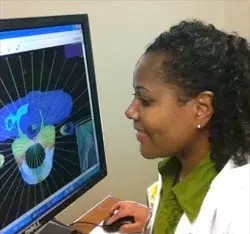Career Profile: Become a Medical or Clinical Physicist

The medical or clinical physicist career at a glance
Education: MS or PhD in medical physics or related field
Additional training: For clinical physics, a residency, CAMPEP, and Board certification is needed for working in the US and Canada. For academic medical physics, postdoctoral training is needed.
Salary: Starting salaries range from $80K - $130K, and mid-career salaries range from $180K - $250K.
Outlook: Medical physics is a highly rewarding career with employment opportunities in academia, industry, clinical and government sectors. There is ample demand for medical physicists in each sector.
What they do
Medical physics opens doors to many types of career paths: one can find research and development work in industry or government, teach and conduct research in academia, or pursue the clinical track. The biomedical tech industry also offers opportunities for entrepreneurship.
A medical physicist in government or industry typically works on:
- Conducting research and development for new technologies
- Translating technologies for clinical use/developing medical equipment
- Testing and managing machines and systems for diagnostics and therapy (e.g., MRI, linacs)
- Training medical personnel (e.g., technologists, dosimetrists) on equipment use
- Marketing new products and developing clinical value propositions
An academic medical physicist has the following responsibilities:
- Mentoring and teaching students and residents
- Writing and applying for grants
- Overseeing research and development on new technologies
- Serving on department committees
- Developing and delivering patient treatments (if in a joint clinical position)
Typical activities for clinical physicists include:
- Consulting with patients and physicians
- Overseeing delivery of treatment to patients, such as radiation treatment for cancer
- Developing patient treatment plans and checking charts
- Performing quality assurance on medical equipment
- Mentoring/training residents and students (if in a joint academic position)
Education & background
In general, a BS in physics or related discipline, followed by an MS or PhD in medical physics is preferred. Graduate training in a related field is also acceptable, but specific jobs may require relevant experience, such as that in nuclear or MRI physics.
Someone pursuing an industry or government job will need an MS or PhD in medical physics or a related field, such as nuclear physics or biophysics. For academic faculty positions a PhD is often required, and a postdoc may be needed before obtaining a permanent position.
For a clinical career as a medical physicist in the US or Canada, either an MS or a PhD should be pursued at a CAMPEP-approved graduate program. Other countries may have different requirements.
Additional training
Following the MS (or PhD), a two-year CAMPEP-accredited residency is required for most clinical positions in the US or Canada. Clinical career paths also require board certification, such as from the American Board of Radiology (ABR), the American Board of Medical Physics (ABMP), the Canadian College of Physicists in Medicine (CCPM), or from other similar organizations.
Additional skills that may help advance one’s career as a medical physicist in any employment sector include: good communication, critical thinking, advanced math, electronics, analytical and problem solving skills. Volunteering at a hospital or interning with a clinical lab can also be beneficial.
For more information, see the American Association of Physicists in Medicine website.
Career path
Industry & government
Following the BS degree, one may become a technician at a company or national lab. After some experience and depending on the person’s preference, they may pursue a management role. Following an MS or PhD degree, the person would start in a research and development role, and can then pursue a management position after five to 10 years. Depending on their preference, the medical physicist may choose to take on business activities, such as monitoring profit/loss for a company. Some medical physicists also choose to become independent consultants or entrepreneurs.
Academia
The career path usually consists of pursuing a postdoctoral position after obtaining a PhD in medical physics or related field, followed by a professorship. The path to advancement in a faculty appointment goes from assistant professor to associate professor to full professor. Some academic medical physicists may become department chairs or find other leadership roles at their institution or within a professional organization.
Clinical
After completing residency, a junior medical physicist will complete certification to become a board certified clinical physicist. After 5+ years, it is possible to move into a leadership role as a senior physicist at a hospital or clinic with financial and personnel management responsibilities.
Other career paths
Medical physics, similarly to any science degree, also opens doors to becoming an editor for a research journal or a science writer. Additional opportunities include working for a non-profit or a foundation, such as the National Foundation for Cancer Research.
Switching between sectors
As there is a lot of overlap between conducting academic research and developing technologies, it is easier for medical physicists, than those in other physics subdisciplines, to horizontally move between an academic or industry career. Also, career moves between academic or industrial and clinical positions are common.
Related

Christina Barrow
Christina Barrow is a medical physicist at the Department of Veteran Affairs in Louisiana.

December Martin
December Martin, a former hardware engineer, manages projects in the biomedical technology industry to produce medical devices.

Julianne Pollard-Larkin
After earning her PhD, Julie decided to become a clinical medical physicist to interact with patients rather than only doing research.

Kathy McCormick
Kathy McCormick is a physical scientist at US Government Accountability Office.